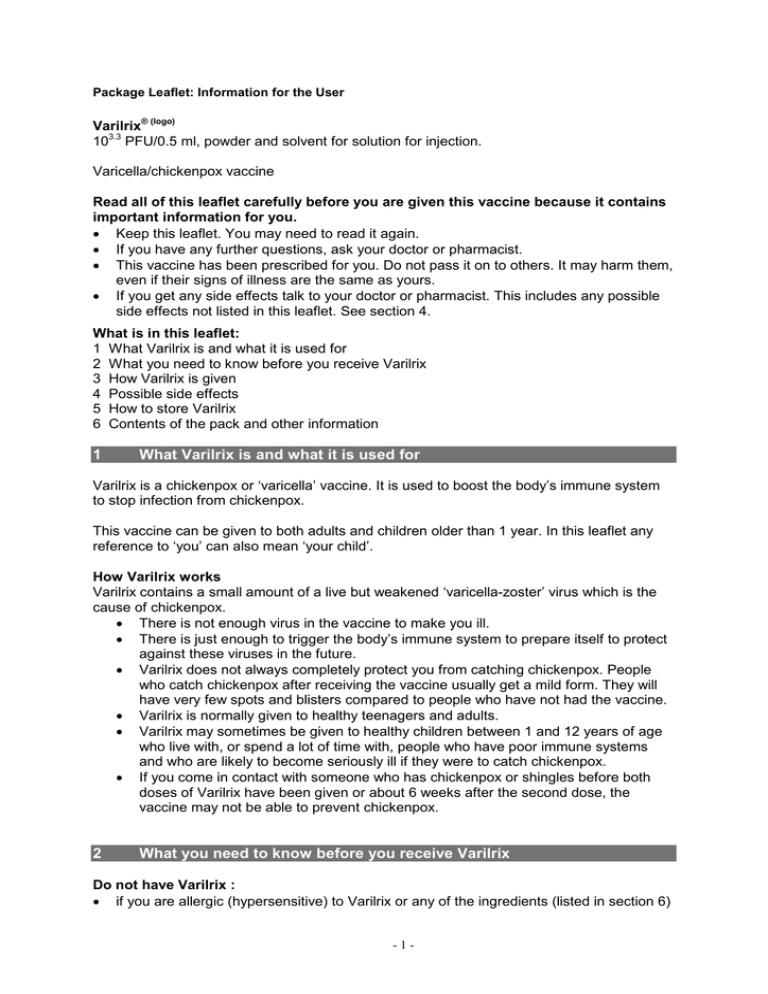
Package Leaflet: Information for the User
® (logo)
Varilrix
103.3 PFU/0.5 ml, powder and solvent for solution for injection.
Varicella/chickenpox vaccine
Read all of this leaflet carefully before you are given this vaccine because it contains
important information for you.
Keep this leaflet. You may need to read it again.
If you have any further questions, ask your doctor or pharmacist.
This vaccine has been prescribed for you. Do not pass it on to others. It may harm them,
even if their signs of illness are the same as yours.
If you get any side effects talk to your doctor or pharmacist. This includes any possible
side effects not listed in this leaflet. See section 4.
What is in this leaflet:
1 What Varilrix is and what it is used for
2 What you need to know before you receive Varilrix
3 How Varilrix is given
4 Possible side effects
5 How to store Varilrix
6 Contents of the pack and other information
1
What Varilrix is and what it is used for
Varilrix is a chickenpox or ‘varicella’ vaccine. It is used to boost the body’s immune system
to stop infection from chickenpox.
This vaccine can be given to both adults and children older than 1 year. In this leaflet any
reference to ‘you’ can also mean ‘your child’.
How Varilrix works
Varilrix contains a small amount of a live but weakened ‘varicella-zoster’ virus which is the
cause of chickenpox.
There is not enough virus in the vaccine to make you ill.
There is just enough to trigger the body’s immune system to prepare itself to protect
against these viruses in the future.
Varilrix does not always completely protect you from catching chickenpox. People
who catch chickenpox after receiving the vaccine usually get a mild form. They will
have very few spots and blisters compared to people who have not had the vaccine.
Varilrix is normally given to healthy teenagers and adults.
Varilrix may sometimes be given to healthy children between 1 and 12 years of age
who live with, or spend a lot of time with, people who have poor immune systems
and who are likely to become seriously ill if they were to catch chickenpox.
If you come in contact with someone who has chickenpox or shingles before both
doses of Varilrix have been given or about 6 weeks after the second dose, the
vaccine may not be able to prevent chickenpox.
2
What you need to know before you receive Varilrix
Do not have Varilrix :
if you are allergic (hypersensitive) to Varilrix or any of the ingredients (listed in section 6)
-1-
if you are allergic (hypersensitive) to any other chickenpox vaccine or neomycin, an
antibiotic used to treat skin infections
if you have a high temperature (fever)
if you have any illness (such as Human Immunodeficiency Virus (HIV) or Acquired
Immunodeficiency Syndrome (AIDS)) or take any medicine that weakens the immune
system. Whether you receive the vaccine will depend on the level of your immune
defences.
if you are pregnant. In addition, pregnancy should be avoided for 1 month following
vaccination.
Do not have Varilrix if any of the above apply to you. If you are not sure, talk to your doctor,
nurse, or pharmacist before receiving Varilrix.
Warnings and precautions
If you answer “Yes” to any of the following questions, talk to your doctor or nurse before the
vaccine is given:
do you have an existing skin condition that has damaged your skin?
do you come into regular contact with pregnant women?
do you have a history or family history of allergies?
do you come into regular contact with people for whom the chickenpox virus could
cause serious health risks? This includes people who have a weak immune system or
people receiving any treatment that can weaken the immune system.
you are due to have a skin test for possible tuberculosis. If this test is done within 6
weeks after receiving Varilrix, the result may not be reliable
Fainting can occur (mostly in adolescents) following, or even before, any needle injection.
Therefore tell the doctor or nurse if you or your child fainted with a previous injection.
People with very poor immune systems (e.g. such as HIV infection) and pregnant women
who have not previously had chickenpox have a small risk of developing severe chickenpox
from the weakened virus. You should be closely monitored as the responses to the
vaccines may not be sufficient to ensure a protection against the illness (see section 2).
Also, depending on the stage of pregnancy, there is a risk of the mother passing on a
severe infection to the unborn child or newborn baby. This has only been shown to happen
when the healthy vaccinated person has developed spots and blisters which usually appear
at the site of the injection.
Other medicines or vaccines and Varilrix
Please tell your doctor, nurse or pharmacist if you are taking, about to be taking or have
recently taken any other medicines. This includes medicines obtained without a prescription,
including herbal medicines. This is because Varilrix can affect the way some other
medicines work. Also some other medicines can affect the way Varilrix works.
Varilrix can be given at the same time as most other routine vaccines, such as travel
vaccines. The doctor will ensure that the vaccines are injected separately and into different
parts of the body. If you are due to have, or have had any other vaccines near to when you
have Varilrix, talk to your nurse before Varilrix is given. If you have received a measles
vaccination recently, vaccination with Varilrix should be delayed until at least one month
after the measles vaccination. Varilrix should not be mixed with other vaccines in the same
syringe.
In particular talk to your doctor if:
you are taking a medicine that can affect the way that your body fights disease. You
should not have Varilrix if you are taking this type of medicine
you are taking aciclovir, a drug used to treat herpes viruses
you have had a blood transfusion or received blood proteins. It is not recommended to
receive Varilrix for 3 months after this treatment
-2-
your child is under the age of 16 and they are due to take aspirin or an aspirin-type
product (also known as salicylates), especially if they have a fever after receiving
Varilrix. Aspirin should not be taken unless on the advice of your doctor.
Pregnancy, breast-feeding and fertility
Do not have Varilrix if you are pregnant.
If you are pregnant or breast-feeding, think you may be pregnant or are planning to
have a baby, ask your doctor for advice before the vaccination is given. Also, it is
important that you do not become pregnant within one month after receiving the
vaccine. During this time you should use an effective method of birth control to avoid
pregnancy.
In case of inadvertent vaccination of pregnant women with Varilrix, this should not be a
reason for termination of pregnancy.
Driving and using machines
Varilrix is not likely to affect you being able to drive or use any tools or machines.However,
some of the effects mentioned under Section 4 “possible side effects” may temporarily affect
the ability to drive or use machines.
Varilrix contains Sorbital.
If you have been told by your doctor that you or your child has an intolerance to some
sugars, contact your doctor before receiving this vaccine.
3
How Varilrix is given
How your vaccine is given
You will never be expected to give yourself this vaccine. It will always be given to you by a
person qualified to do so.
You will have Varilrix:
as an injection under your skin, usually in the upper arm
your doctor or nurse will usually wipe the skin clean around the place where you will
have the injection using alcohol or another antiseptic.
How much is given
Children older than 1 year and adults:
Each time you receive Varilrix, it will be given to you as a single 0.5 ml injection.
You will have two separate doses.
There will be an interval of at least 6 weeks (never less than 4 weeks) between the first
and second doses.
If you miss the due date for the second injection, you should still be given the second
dose as soon as this can be arranged. The second injection ensures that protection
against chickenpox will be continued.
If you have more Varilrix than you need
It is unlikely that you will be given too much Varilrix.
4
Possible side effects
Like all vaccines, Varilrix can cause side effects although not everybody gets them. In adults
and young people the second dose is not likely to cause more severe side effects than the
first dose.
-3-
Allergic reactions:
If you have an allergic reaction, see your doctor straight away. Very rarely you may
experience:
facial swelling
low blood pressure
difficulty breathing
your skin going blue
loss of consciousness.
Should these reactions happen, they will usually start very soon after the injection has been
given to you. Seek medical help straight away if they happen after leaving the clinic.
Other side effects include:
Very common (affects more than 1 in 10 people)
reactions at the site of the injection. These include redness, pain and swelling.
high temperature (fever)
Common (affects less than 1 in 10 people)
rash
Uncommon (affects less than 1 in 100 people)
swollen glands
headache
drowsiness
sore throat or cough
runny nose
feeling sick or being sick
rash with blisters
itching
joint or muscle pain
very high temperature
tiredness
feeling generally unwell
feeling irritable
Rare (affects less than 1 in 1,000 people)
eye infection
stomach ache
diarrhoea
hives
painful rash with blisters (Shingles)
reduction in platelets, increases risk of bleeding and bruising
inflammation of blood vessels
fits
loss of control of body movements e.g.inability to walk or speak properly
inflammation or infection of the brain
stroke
severe condition of the skin that may affect the mouth and other parts of the body
Very rare (affects less than 1 in 10,000 people)
dizziness
facial swelling, allergic reactions
-4-
If any of the side effects get serious, or you notice any side effects not listed in this leaflet,
tell your doctor or pharmacist.
Reporting of side effects
If you get any side effects, talk to your doctor, pharmacist or nurse. This includes any
possible side effects not listed in this leaflet. You can also report side effects directly via the
Yellow Card Scheme at: www.mhra.gov.uk/yellowcard.
By reporting side effects you can help provide more information on the safety of this
medicine.
5
6
How to store Varilrix
Keep out of the sight and reach of children.
Store between 2°C and 8°C in a refrigerator.
Varilrix in powder form is not affected by freezing but must not be frozen after being
made up.
Do not store for more than 60 minutes at room temperature (25°C) or 8 hours if kept in a
refrigerator after the injection has been made up.
Do not use Varilrix after the expiry date which is stated on the label and carton.
Store in the original package with this leaflet.
Do not throw away any medicines via wastewater or household waste. Ask your
pharmacist how to throw away medicines you no longer use. These measures will help
protect the environment.
Contents of the pack and other information
What Varilrix contains
The active ingredient is live attenuated Varicella zoster (Oka strain) virus prepared in
MRC5 human diploid cells.
Each 0.5 ml dose contains not less than 103.3 plaque forming units (PFU) of this virus.
The other ingredients are amino acids, human albumin, lactose, mannitol and sorbitol.
What Varilrix looks like and contents of the pack
Varilrix is a creamy yellowish or pinkish coloured pellet or powder in 3 ml vials. The pack
also contains a separate 1 ml glass ampoule containing a colourless sterile liquid (Water for
Injections). Once made up Varilrix is clear peach to pink coloured solution. The vaccine is
available in packs of 1.
Marketing Authorisation Holder and Manufacturer
Marketing Authorisation Holder:
SmithKline Beecham Ltd, Stockley Park West, Uxbridge, Middlesex, UB11 1BT
Manufacturer:
GlaxoSmithKline Biologicals s.a., Rixensart, Belgium.
Other formats:
To listen to or request a copy of this leaflet in Braille, large print or audio please call, free of
charge:
0800 198 5000 (UK only).
Please be ready to give the following information:
Product name
Varilrix
Reference number 10592/0121
-5-
This is a service provided by the Royal National Institute of Blind People.
This leaflet was revised in October 2014
Varilrix is a registered trade mark of the GSK of companies.
2014 GSK group of companies. All rights reserved.
-6-






